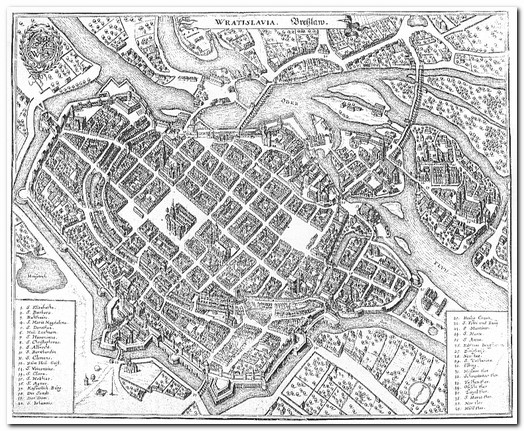

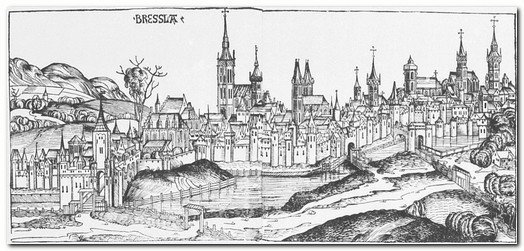 Probably most of you have heard, that in the year 2000 Wroclaw celebrated its millenium. One is mistaken though, who thinks that colourful tale about the history of the city began in the year 1000, when a chronicler named Thiermar wrote down the first record in history about Vratislavia, a settlement of a sound size situated over the Oder in the heart of Silesia,
Probably most of you have heard, that in the year 2000 Wroclaw celebrated its millenium. One is mistaken though, who thinks that colourful tale about the history of the city began in the year 1000, when a chronicler named Thiermar wrote down the first record in history about Vratislavia, a settlement of a sound size situated over the Oder in the heart of Silesia,
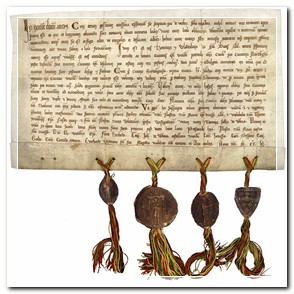 where the most important trading routes meet. It was big enough to be chosen as a seat of a new bishopric by the emperor Otto III and Bolesław I the Brave, at the time Duke of Poland, and its first King since 1025. First settlements in this region cameinto existence in VI century B.C. and in I century B.C. Wroclaw was already a strong transit center on the road of amber route, which was used to transfer valuable and as rumour has it – magical material from the Baltic Sea to the Roman Empire. Remains of this period in the history of the city can be found today as roman coins, ceramics and amber “treasures”. The heaviest weighed even 2750 kg! Attractive trading localization was the reason why even Celts settled here.
where the most important trading routes meet. It was big enough to be chosen as a seat of a new bishopric by the emperor Otto III and Bolesław I the Brave, at the time Duke of Poland, and its first King since 1025. First settlements in this region cameinto existence in VI century B.C. and in I century B.C. Wroclaw was already a strong transit center on the road of amber route, which was used to transfer valuable and as rumour has it – magical material from the Baltic Sea to the Roman Empire. Remains of this period in the history of the city can be found today as roman coins, ceramics and amber “treasures”. The heaviest weighed even 2750 kg! Attractive trading localization was the reason why even Celts settled here.
According to tradition the settlement in Wroclaw was supposed to be established by Czech prince Vratislav I (reigning in 915-921) and his name was reportedly used in naming the city. However, first settlement on Ostrow Tumski was built by the prince of the Polans, Mieszko I in 985.
Later history of Wroclaw is continuous changes of national adherence, which as a matter of fact,
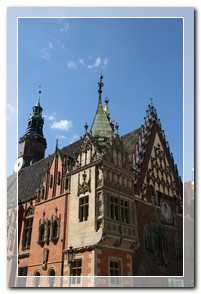 found its reflection in the city’s crest presenting a Czech lion with a double tail next to a silesian eagle. As early as in 1038 the city was captured by a Czech prince - Brzetyslaw I, but in 1050 it returned to contemporary borders of the country of Polans. In 1109 Wroclaw was taken by a german king – Henry V, but he had to leave it as he was defeated by Bolesław III Wrymouth (Duke 1102-1138) on a land that from now on was called Psie Pole (Dog’s Field) on the memento of the dogs, which after the battle fed themselves with dead bodies meat.
found its reflection in the city’s crest presenting a Czech lion with a double tail next to a silesian eagle. As early as in 1038 the city was captured by a Czech prince - Brzetyslaw I, but in 1050 it returned to contemporary borders of the country of Polans. In 1109 Wroclaw was taken by a german king – Henry V, but he had to leave it as he was defeated by Bolesław III Wrymouth (Duke 1102-1138) on a land that from now on was called Psie Pole (Dog’s Field) on the memento of the dogs, which after the battle fed themselves with dead bodies meat.
In 1335 after the death of Henry VI the Good the duchy of Wroclaw became once again in the hands of Czech crown. While being alive Henry VI made an arrangement, whereby after his death John of Luxembourg will be the owner of the duchy of Wroclaw. In this period the city of Wroclaw experienced the biggest artistic and architectural development in history. During this period impressive buildings were made, such as gothic churches and even a city hall, which was so beautifully and richly constructed that it symbolised the splendor and earnings of the townspeople.
In 1469–1526 Wroclaw along with the whole Silesia was under the rules of Jagiellons from Hungary, in sequence – Wladyslaw, Zygmunt and Ludwik. In 1526
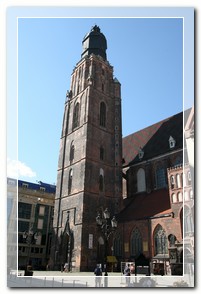 in the battle of Mohacz against the Turkish army died Ludwik Jagiellonczyk, who was the king of Czech and Hungary. Wroclaw was taken by the Habsburgs. Concurrently a reformation was rising in power and it reached Wroclaw in 1523. It was led by a man named John Hess, a close friend of Luter’s. The reformation was spreading throughout the city very quickly. One year later most of the citizens of the city along with the city council accepted protestantism. The only catholic shrines and monasteries left were the ones situatied in Ostrow Tumski and some of those situated in villages in the outskirts of the city.
in the battle of Mohacz against the Turkish army died Ludwik Jagiellonczyk, who was the king of Czech and Hungary. Wroclaw was taken by the Habsburgs. Concurrently a reformation was rising in power and it reached Wroclaw in 1523. It was led by a man named John Hess, a close friend of Luter’s. The reformation was spreading throughout the city very quickly. One year later most of the citizens of the city along with the city council accepted protestantism. The only catholic shrines and monasteries left were the ones situatied in Ostrow Tumski and some of those situated in villages in the outskirts of the city.
The golden age of the city’s development finished suddenly when in 1618 The 30 Years War started. The city itself wasn’t captured during this war, but numerous battles on the area of Silesia, difficulties in trading, marches of armies, epidemics and contributions had a bad influence on Wroclaw. The fall of trading and craft and most of all – the decrease of population – were some of the problems,
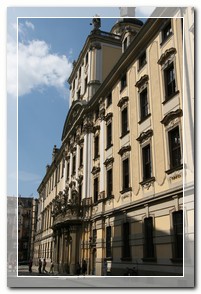 which Wroclaw had to cope with. The Peace of Westphalia had finally ended The 30 Year War, but the victory of the catholic camp has limited the way of life and religious freedom of Wroclaw’s protestants. It also had coused a gradual passing of catholic religion, which was reluctantly accepted by the citizens of Wroclaw (in 1885 most of the citizens, which is 173,000 declared Protestant religion, 109,000 Catholic religion and 18,000 Judaism). The Jesuits, who were brought to Wroclaw in 1638, had a great share in the graduall passing of Catholic religion in this region. Their college transformed into a university in 1702 and it was sponsored by Leopold I. In 1741 as a result of the Silesian Wars, Wroclaw again changed its adherence, but this time it belonged to Prussia. Fredrik II fortificated the city, of course with the city’s money and created one of the best Prussian strongholds. Simultaneously, he ruined the city economicly.
which Wroclaw had to cope with. The Peace of Westphalia had finally ended The 30 Year War, but the victory of the catholic camp has limited the way of life and religious freedom of Wroclaw’s protestants. It also had coused a gradual passing of catholic religion, which was reluctantly accepted by the citizens of Wroclaw (in 1885 most of the citizens, which is 173,000 declared Protestant religion, 109,000 Catholic religion and 18,000 Judaism). The Jesuits, who were brought to Wroclaw in 1638, had a great share in the graduall passing of Catholic religion in this region. Their college transformed into a university in 1702 and it was sponsored by Leopold I. In 1741 as a result of the Silesian Wars, Wroclaw again changed its adherence, but this time it belonged to Prussia. Fredrik II fortificated the city, of course with the city’s money and created one of the best Prussian strongholds. Simultaneously, he ruined the city economicly.
At the end of 1806 a very important epizode occured for Wroclaw — The Napoleonic Wars. Napoleon’s armies defeated the Prussian
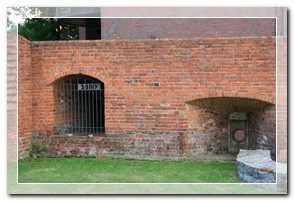 army in the battle of Jena and then they moved eastwards. The IX French Corps under command of the youngest Napoleon’s brother – Jerome, besieged Wroclaw from 6 December 1806 to its capitulation on 7 January 1807.
One of his first decisions was to destroy the fortifications and city’s walls. As a result only small remains of it exist nowadays. Paradoxically, this decision helped Wroclaw to gain new areas of land. The city’s area extanded from 350 to 2050 hectares in a few years and the number of citizens surpassed 65 thousands.
army in the battle of Jena and then they moved eastwards. The IX French Corps under command of the youngest Napoleon’s brother – Jerome, besieged Wroclaw from 6 December 1806 to its capitulation on 7 January 1807.
One of his first decisions was to destroy the fortifications and city’s walls. As a result only small remains of it exist nowadays. Paradoxically, this decision helped Wroclaw to gain new areas of land. The city’s area extanded from 350 to 2050 hectares in a few years and the number of citizens surpassed 65 thousands.
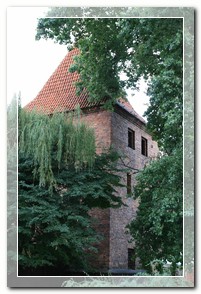 In 1811 the University of Wroclaw was connected with a Prussian Protenstant University, Viadrina from Frankfurt (Oder), whereby Wroclaw’s univeristy gained a precious library and new lecturers. Thanks to that, the city opened a new penta-depertamental laic university. During the whole XIX century the city changed its character — the city’s industry and local governments developed, parks were built, bridges and buildings of public usefulness, first horse-trolley lines were established, a huge railway infrastructure and fair inland shipping conditions were being created.
In 1811 the University of Wroclaw was connected with a Prussian Protenstant University, Viadrina from Frankfurt (Oder), whereby Wroclaw’s univeristy gained a precious library and new lecturers. Thanks to that, the city opened a new penta-depertamental laic university. During the whole XIX century the city changed its character — the city’s industry and local governments developed, parks were built, bridges and buildings of public usefulness, first horse-trolley lines were established, a huge railway infrastructure and fair inland shipping conditions were being created.
Wroclaw entered the XX century as a city with 500,000 citizens. Beside industry and trading, the science life was also blooming. University of Wroclaw had already a few noblists, in 1910 Higher Technical School was created,which later was transformed into Wroclaw University of Technology and a year later Academy of Fine Arts. Theatrical and musical life turned Wroclaw into one of the most important cultural centers in Germany.
The beginning of the First World War caused a sudden crash of the economy in spite of the fact that direct military operations did not affect the borders of the city. When in 1918 Wroclaws community heard about polish demarches
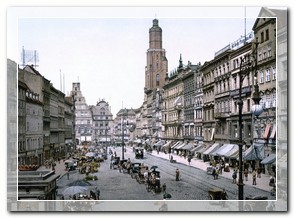 on a treaty deliberation in Paris regarding the takeover of the Upper Silesia, anti-polish attitudes started to arise throughout the city. Finally, Silesia has been divided into two provinces — Upper and Lower. In result, Wroclaw lost its prestigue and from now on it was the capital city of the Lower Silesia only.
on a treaty deliberation in Paris regarding the takeover of the Upper Silesia, anti-polish attitudes started to arise throughout the city. Finally, Silesia has been divided into two provinces — Upper and Lower. In result, Wroclaw lost its prestigue and from now on it was the capital city of the Lower Silesia only.
Interwar years in Wroclaw have passed as a struggle with an economic crisis, but the whole world was suffering at the same time. Repressions towards polish and jewish minorities have arised, especially at the beginning of 30s, after Hitler came to power. In 1938 some street riots occured, during which jewish shops and flats were demolished and the Synagogue was set on fire.
Throughout the whole World War II millitary operations did not stricke Wroclaw. The city became even a shelter for civilians evacuated from Germany and also for numerous facilities of millitary industry. By the end of 1944
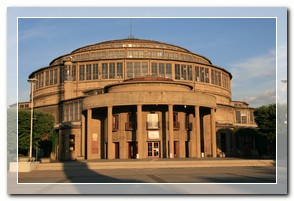 the number of people staying in it changed from 640,000 to 1,000,000. Just at the end of the war, in January 1945, when the troops of the Red Army were getting closer to Silesia, compulsory evacuations were directed (the first one went to Dresden, but the city itself was later destroyed by air bombs). For 4 months, from 13 February to 6 May, the city of Wroclaw was besieged. 70% of the city was destroyed. Wroclaw surrendered as one of the last German cities, 4 days after Berlin was captured, two days before announcing the end of the war in Europe.
the number of people staying in it changed from 640,000 to 1,000,000. Just at the end of the war, in January 1945, when the troops of the Red Army were getting closer to Silesia, compulsory evacuations were directed (the first one went to Dresden, but the city itself was later destroyed by air bombs). For 4 months, from 13 February to 6 May, the city of Wroclaw was besieged. 70% of the city was destroyed. Wroclaw surrendered as one of the last German cities, 4 days after Berlin was captured, two days before announcing the end of the war in Europe.
On behalf of the actions established on the Potsdam Conference, where a decision was made that Wroclaw and Silesia belong to Poland, a massive displacement of citizens was about to begin.
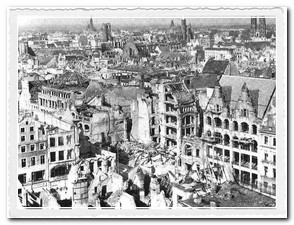 People, who survived from “festung Breslau” were replaced by a wave of so called pioneers from Greater Poland and from eastern lands returned to USRR. A famous anecdote was created because of that situation, where one of the two old men going by train from Wroclaw to Cracow asks the other one:
People, who survived from “festung Breslau” were replaced by a wave of so called pioneers from Greater Poland and from eastern lands returned to USRR. A famous anecdote was created because of that situation, where one of the two old men going by train from Wroclaw to Cracow asks the other one:
- Are you from Wroclaw?
- Yes
- Ohh!...I’m from Lviv too.
Anyway, at present many of Wroclaw’s citizens, especially the older ones, have got a singing accent, which is characteristic for Lviv’s community.
The rise of Wroclaw straight from ruins started right after the end of the war. The beginnings weren’t easy though.
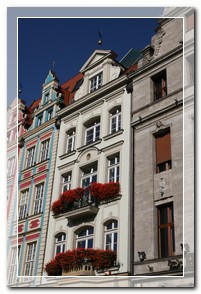 Reconstruction of the city was much more difficult because of factory robberies, which were commited by the Red Army slowly retreating from the city’s borders. Another obstacle was that all cars, tram-cars, furniture and random equipment, and even bricks from medieval monuments damaged during the besiegement, were being transported to Warsaw, which was also being reconstructed. However, in autumn 1945, first offices, communications lines and schools (University of Wroclaw on 15 November) were opened. The city’s citizen potential was recovered at the and of 50s. Very fast Wroclaw became one of the most important urban centres, but also cultural, economic and scientific in the country. Heavy industry was strongly developed. The ideas of “Solidarity” had a solid background to focus on. The year 1980 was full of strikes all over the country and “Solidarity” was supported by 250,000 members. The years after comunizm was abolished were fruitful for Wroclaw, which is now the fourth city in the country if it comes to size and the biggest one in the western part of Poland.
Reconstruction of the city was much more difficult because of factory robberies, which were commited by the Red Army slowly retreating from the city’s borders. Another obstacle was that all cars, tram-cars, furniture and random equipment, and even bricks from medieval monuments damaged during the besiegement, were being transported to Warsaw, which was also being reconstructed. However, in autumn 1945, first offices, communications lines and schools (University of Wroclaw on 15 November) were opened. The city’s citizen potential was recovered at the and of 50s. Very fast Wroclaw became one of the most important urban centres, but also cultural, economic and scientific in the country. Heavy industry was strongly developed. The ideas of “Solidarity” had a solid background to focus on. The year 1980 was full of strikes all over the country and “Solidarity” was supported by 250,000 members. The years after comunizm was abolished were fruitful for Wroclaw, which is now the fourth city in the country if it comes to size and the biggest one in the western part of Poland.
